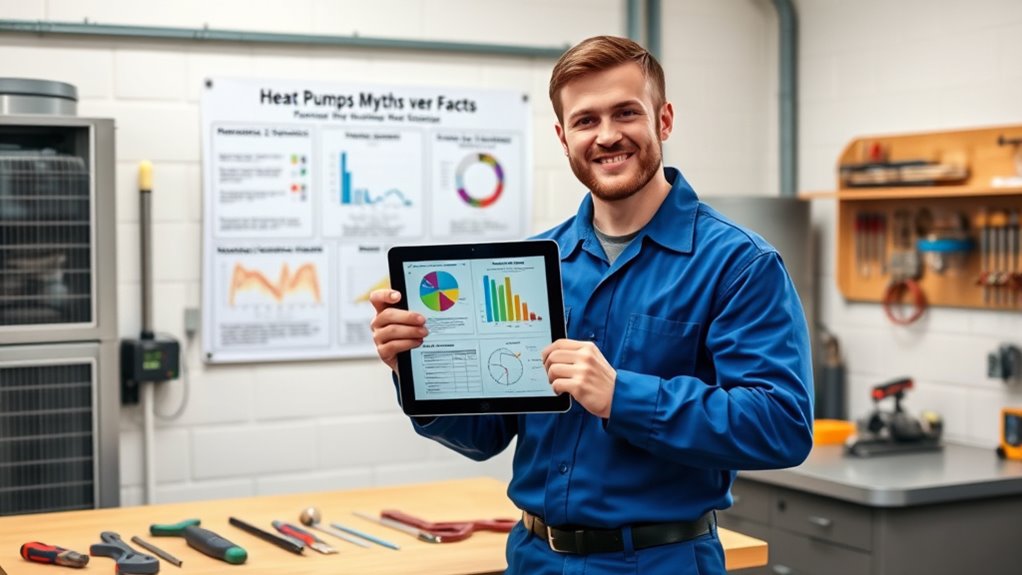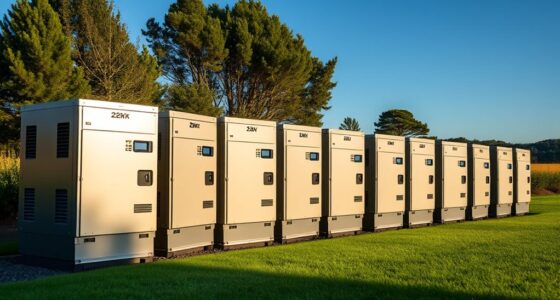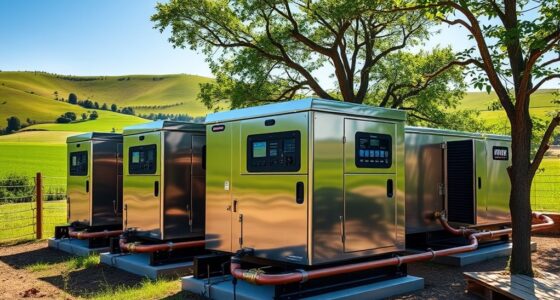To quickly size heat pumps and well pumps, avoid common myths like relying solely on home square footage or guessing based on past experiences. Focus on understanding your home’s unique heating, cooling, and water needs, considering factors such as insulation, climate, and usage patterns. Using simple load calculations and efficiency ratings helps you make smarter choices. Keep in mind, proper sizing maximizes performance and lifespan—continue exploring for expert tips and step-by-step guidance.
Key Takeaways
- Accurate load calculations considering climate, insulation, and usage are essential for proper heat pump and well pump sizing.
- Avoid sizing solely based on home square footage; focus on specific demand rather than assumptions.
- Oversized systems cycle frequently, reducing efficiency and lifespan, while undersized units struggle to meet demand.
- Use manufacturer guidelines, efficiency ratings, and professional advice to verify appropriate system size.
- Proper sizing maximizes energy efficiency, reduces operational costs, and prevents system breakdowns.
Common Misconceptions About Heat Pump and Well Pump Sizing

Many people believe that sizing a heat pump or well pump is as simple as matching the equipment’s capacity to their home’s square footage. This is a common efficiency myth that can lead to improper sizing. Oversized systems may cycle frequently, reducing efficiency and increasing wear, while undersized units struggle to meet demand. Additionally, many assume installation challenges are minimal, but improper sizing can complicate setup and lead to costly adjustments later. Sizing isn’t just about numbers; it involves understanding your home’s unique needs and site conditions. Relying solely on square footage ignores these critical factors, risking system inefficiency and potential breakdowns. Correct sizing requires careful assessment, not guesswork based on surface-level assumptions. Proper system design considers all relevant variables, ensuring optimal performance and longevity.
Key Factors to Determine the Right Size Quickly

To determine the right size for your heat pump or well pump quickly, start by evaluating your home’s specific heating and cooling needs, rather than relying solely on square footage. Conduct a simple load calculation that considers insulation, window efficiency, and climate factors to accurately estimate demand. This helps prevent oversizing or undersizing, which can waste energy or reduce comfort. Focus on efficiency enhancement by choosing equipment that matches your load calculation; a properly sized pump runs more efficiently, saves energy, and extends equipment lifespan. Avoid guesswork—use these key factors to make an informed decision fast. By systematically assessing your home’s unique needs, you’ll ensure optimal performance without lengthy or complicated processes. Additionally, understanding the growth conditions of chia seeds can help ensure your homegrown seeds are of the highest quality and yield.
Quick Tips for Accurate Sizing and Avoiding Costly Mistakes

Ensuring your heat pump or well pump is correctly sized hinges on applying simple but effective tips. Proper sizing maximizes efficiency improvements and minimizes costly mistakes. First, always perform a detailed load calculation considering local climate, insulation, and usage patterns to avoid under or over-sizing. Second, compare system options based on energy efficiency ratings, focusing on units with high SEER or GPM ratings, to optimize long-term cost analysis. Third, consult manufacturer guidelines and get professional input to verify your sizing choices. These steps help prevent inefficiencies, reduce energy bills, and guarantee smooth operation. Remember, accurate sizing isn’t just about fitting equipment but about maximizing performance and minimizing future expenses. Following these tips ensures your investment yields the best results. Additionally, understanding the types of headphone jacks can be useful if you need to connect audio equipment for troubleshooting or presentations related to your home systems.
Frequently Asked Questions
How Often Should I Re-Evaluate My Heat Pump and Well Pump Sizes?
You should re-evaluate your heat pump and well pump sizes every 3 to 5 years or if your household size or water needs change. Regular maintenance schedules help make certain they run efficiently, preventing overworking or underperformance. By periodically reassessing, you can implement efficiency improvements, save energy, and extend equipment lifespan. Stay attentive to any signs of reduced performance, and consult a professional if you notice issues or significant changes.
Can DIY Tools Accurately Size Heat and Well Pumps?
DIY tools can give you a rough estimate, but they often lack the sizing accuracy needed for your heat and well pumps. While these tools are helpful for initial guidance, they don’t replace professional assessments, which consider your home’s specific needs. Relying solely on DIY tools might lead to undersized or oversized systems, reducing efficiency and lifespan. For precise sizing, consulting a professional is always the best choice.
What Are the Signs of an Improperly Sized Heat Pump?
Imagine trying to fit a puzzle piece that’s too big or too small—you’ll notice gaps or overlaps. Similarly, signs of an improperly sized heat pump include inconsistent heating, short cycling, and high energy bills. These issues hint at sizing inaccuracies that hinder efficiency improvement. If your system struggles to maintain comfort or runs constantly, it’s time to revisit sizing accuracy to guarantee peak performance and savings.
How Do Local Climate Changes Affect Pump Sizing Needs?
You need to take into account climate impact when sizing your pump, as changing weather patterns can affect heating or cooling loads. Warmer winters might mean you need a smaller pump, while colder spells demand more capacity. Stay aware of seasonal shifts and make sizing adjustments accordingly. This ensures your heat or well pump operates efficiently, saving energy and extending its lifespan despite climate fluctuations.
Are There Industry Standards for Quick Sizing Assessments?
Yes, industry guidelines and sizing benchmarks exist to help you perform quick assessments. These standards provide practical, streamlined methods to estimate pump sizes efficiently without detailed calculations. By following recommended practices from organizations like the Hydraulic Institute or ASHRAE, you guarantee your sizing is accurate and consistent. Using these benchmarks simplifies decision-making, saves time, and helps you confidently select the right pump size for specific applications.
Conclusion
Think of sizing your heat or well pump like fitting a puzzle piece—if it’s too small, it won’t do the job; too big, it wastes energy. By understanding the key factors and avoiding common myths, you’re crafting a perfect fit that works efficiently. Remember, quick and accurate sizing is like finding that missing piece—ensures smooth operation and saves you money. Get it right the first time, and your system will serve you well for years to come.









